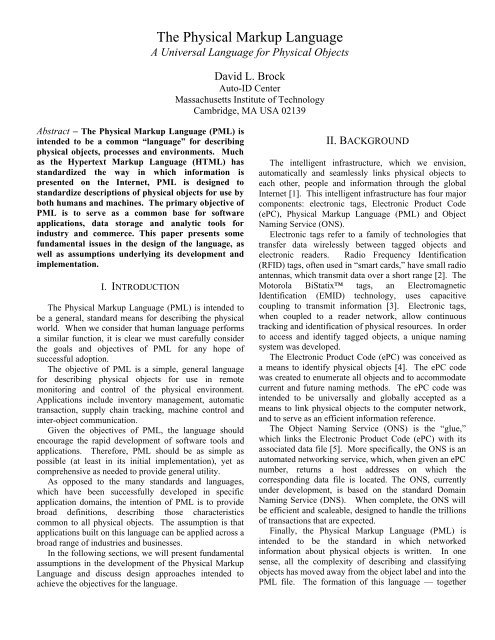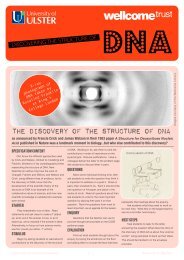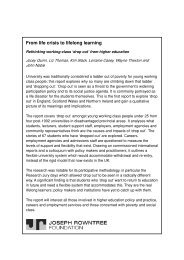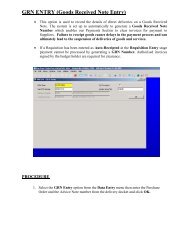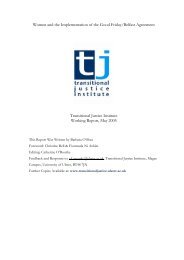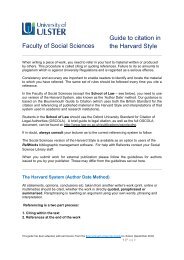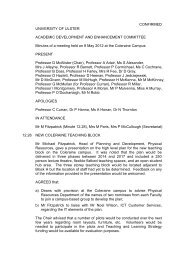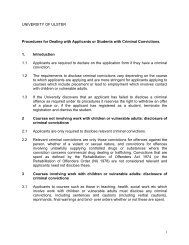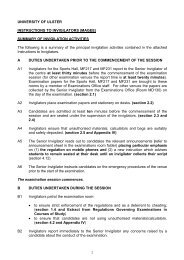The Physical Markup Language - Auto-ID Labs
The Physical Markup Language - Auto-ID Labs
The Physical Markup Language - Auto-ID Labs
You also want an ePaper? Increase the reach of your titles
YUMPU automatically turns print PDFs into web optimized ePapers that Google loves.
Abstract – <strong>The</strong> <strong>Physical</strong> <strong>Markup</strong> <strong>Language</strong> (PML) is<br />
intended to be a common “language” for describing<br />
physical objects, processes and environments. Much<br />
as the Hypertext <strong>Markup</strong> <strong>Language</strong> (HTML) has<br />
standardized the way in which information is<br />
presented on the Internet, PML is designed to<br />
standardize descriptions of physical objects for use by<br />
both humans and machines. <strong>The</strong> primary objective of<br />
PML is to serve as a common base for software<br />
applications, data storage and analytic tools for<br />
industry and commerce. This paper presents some<br />
fundamental issues in the design of the language, as<br />
well as assumptions underlying its development and<br />
implementation.<br />
I. INTRODUCTION<br />
<strong>The</strong> <strong>Physical</strong> <strong>Markup</strong> <strong>Language</strong> (PML) is intended to<br />
be a general, standard means for describing the physical<br />
world. When we consider that human language performs<br />
a similar function, it is clear we must carefully consider<br />
the goals and objectives of PML for any hope of<br />
successful adoption.<br />
<strong>The</strong> objective of PML is a simple, general language<br />
for describing physical objects for use in remote<br />
monitoring and control of the physical environment.<br />
Applications include inventory management, automatic<br />
transaction, supply chain tracking, machine control and<br />
inter-object communication.<br />
Given the objectives of PML, the language should<br />
encourage the rapid development of software tools and<br />
applications. <strong>The</strong>refore, PML should be as simple as<br />
possible (at least in its initial implementation), yet as<br />
comprehensive as needed to provide general utility.<br />
As opposed to the many standards and languages,<br />
which have been successfully developed in specific<br />
application domains, the intention of PML is to provide<br />
broad definitions, describing those characteristics<br />
common to all physical objects. <strong>The</strong> assumption is that<br />
applications built on this language can be applied across a<br />
broad range of industries and businesses.<br />
In the following sections, we will present fundamental<br />
assumptions in the development of the <strong>Physical</strong> <strong>Markup</strong><br />
<strong>Language</strong> and discuss design approaches intended to<br />
achieve the objectives for the language.<br />
<strong>The</strong> <strong>Physical</strong> <strong>Markup</strong> <strong>Language</strong><br />
A Universal <strong>Language</strong> for <strong>Physical</strong> Objects<br />
David L. Brock<br />
<strong>Auto</strong>-<strong>ID</strong> Center<br />
Massachusetts Institute of Technology<br />
Cambridge, MA USA 02139<br />
II. BACKGROUND<br />
<strong>The</strong> intelligent infrastructure, which we envision,<br />
automatically and seamlessly links physical objects to<br />
each other, people and information through the global<br />
Internet [1]. This intelligent infrastructure has four major<br />
components: electronic tags, Electronic Product Code<br />
(ePC), <strong>Physical</strong> <strong>Markup</strong> <strong>Language</strong> (PML) and Object<br />
Naming Service (ONS).<br />
Electronic tags refer to a family of technologies that<br />
transfer data wirelessly between tagged objects and<br />
electronic readers. Radio Frequency Identification<br />
(RF<strong>ID</strong>) tags, often used in “smart cards,” have small radio<br />
antennas, which transmit data over a short range [2]. <strong>The</strong><br />
Motorola BiStatix tags, an Electromagnetic<br />
Identification (EM<strong>ID</strong>) technology, uses capacitive<br />
coupling to transmit information [3]. Electronic tags,<br />
when coupled to a reader network, allow continuous<br />
tracking and identification of physical resources. In order<br />
to access and identify tagged objects, a unique naming<br />
system was developed.<br />
<strong>The</strong> Electronic Product Code (ePC) was conceived as<br />
a means to identify physical objects [4]. <strong>The</strong> ePC code<br />
was created to enumerate all objects and to accommodate<br />
current and future naming methods. <strong>The</strong> ePC code was<br />
intended to be universally and globally accepted as a<br />
means to link physical objects to the computer network,<br />
and to serve as an efficient information reference.<br />
<strong>The</strong> Object Naming Service (ONS) is the “glue,”<br />
which links the Electronic Product Code (ePC) with its<br />
associated data file [5]. More specifically, the ONS is an<br />
automated networking service, which, when given an ePC<br />
number, returns a host addresses on which the<br />
corresponding data file is located. <strong>The</strong> ONS, currently<br />
under development, is based on the standard Domain<br />
Naming Service (DNS). When complete, the ONS will<br />
be efficient and scaleable, designed to handle the trillions<br />
of transactions that are expected.<br />
Finally, the <strong>Physical</strong> <strong>Markup</strong> <strong>Language</strong> (PML) is<br />
intended to be the standard in which networked<br />
information about physical objects is written. In one<br />
sense, all the complexity of describing and classifying<br />
objects has moved away from the object label and into the<br />
PML file. <strong>The</strong> formation of this language — together


